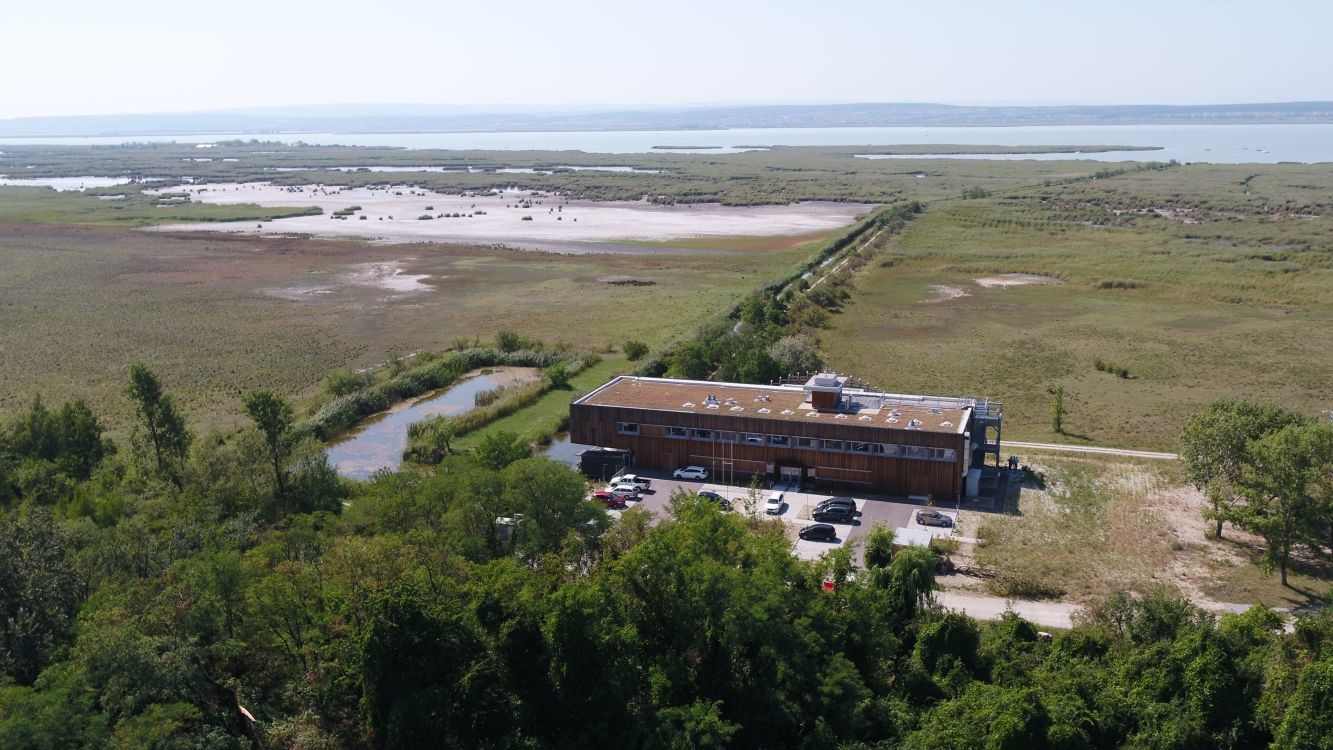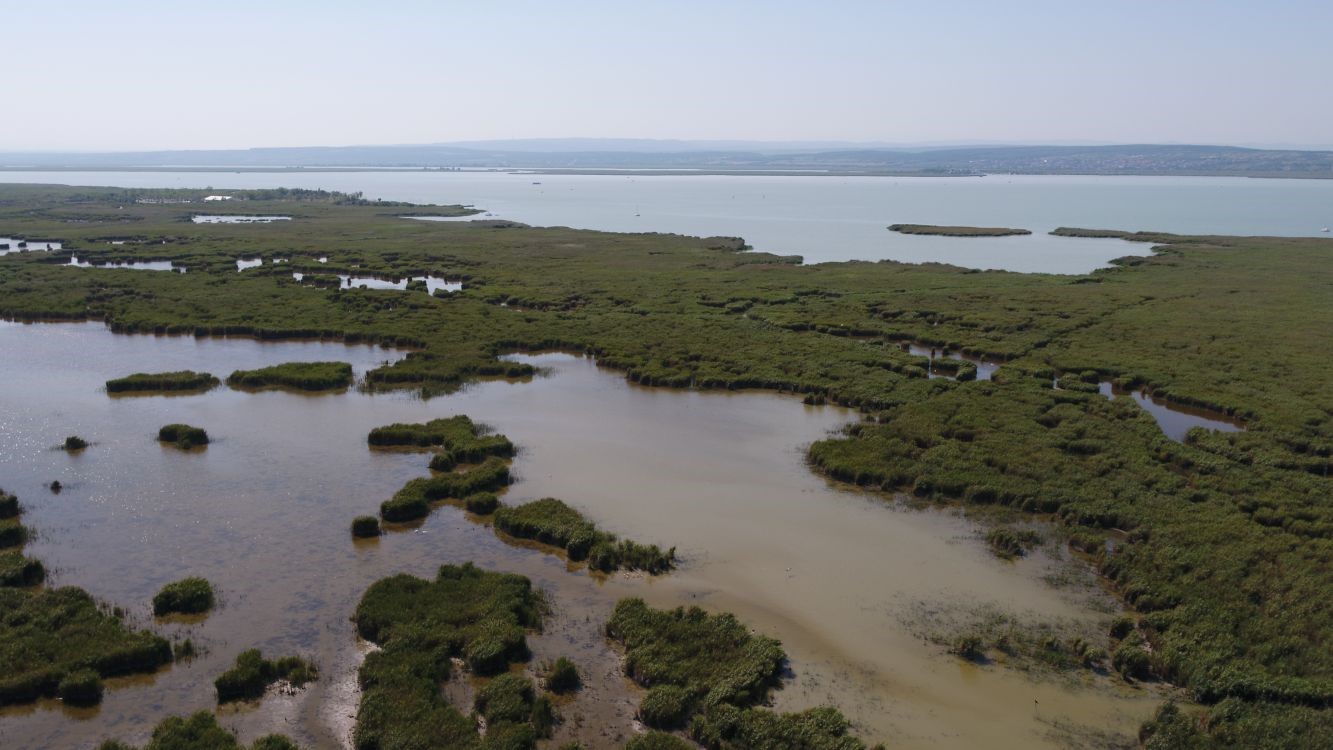Biologische Station Neusiedler See (Regular)
Operator: Amt der Burgenländischen Landesregierung (Provincial Government Burgenland)
DEIMS-SDR Database: Biologische Station Neusiedler See
Contact: Thomas Zechmeister and Justin Catau
Site description
The Biologische Station Neusiedler See is situated at Lake Neusiedl in Illmitz (Austria). It is a service department of the provincial government of Burgenland. The institution offers high scale experience in basic and applied ecological research in Burgenland over the last 50 years. Located in the middle of the Neusiedler See – Seewinkel national park, the Biological Station hosts a high standard chemical and microbiological laboratory for water analysis, which has an accreditation for a variety of physico-chemical, chemical and microbiological parameters as well as for diverse sampling procedures. The institution provides expert opinion for water quality as well as applied cross-sectoral research and ecosystem monitoring.
With several different subsites and partners (ABOL/Natural History Museum Vienna, Hydrographic Service Burgenland, Medical University of Vienna, University of Vienna, Environment Agency Austria), the Biological Station is able to provide long-term data regarding meteorology, limnology, lake chemistry, entomology, botany, air quality and carbon-fluxes.
Thus, the Biological Station provides bases for decision making with regard to the development of a balanced cultural landscape.

The Biological Station is a well-known cooperation partner of local, regional, national and international institutions, stakeholders, universities and state offices of Burgenland.
In cooperation with the Neusiedler See – Seewinkel national park, the Biological Station coordinates the activities of the LTSER Platform Neusiedler See – Seewinkel and will participate in the GLEON network in near future.

Publications
- Baur, P.A.; Henry Pinilla, D.; Glatzel, S. (2024): Is ebullition or diffusion more important as methane emission pathway in a shallow subsaline lake?, Science of The Total Environment, Volume 912, 2024, 169112, ISSN 0048-9697, https://doi.org/10.1016/j.scitotenv.2023.169112.
- Dmitry Kishkinev, Florian Packmor, Thomas Zechmeister, Hans-Christoph Winkler, Nikita Chernetsov, Henrik Mouritsen, Richard A. Holland (2021): Navigation by extrapolation of geomagnetic cues in a migratory songbird, Current Biology, https://doi.org/10.1016/j.cub.2021.01.051.
- Albert R., Werner V. & Popp M. with contributions by Fischer M.A. & Niklfeld H. (2020): Botanische Kostbarkeiten vor unserer Haustür - Die Salzpflanzen im Gebiet des Neusiedler Sees, Burgenland (Österreich), Acta ZooBot Austria 157, 115–143.
- Horváth Z., Ptacnik R., Vad C. F., Chase, J. M. (2019): Habitat loss over six decades accelerates regional and local biodiversity loss via changing landscape connectance. Ecology Letters 22: 1019–1027.
- Weyhenmeyer GA, Hartmann J, o. Hessen D, Kopácek J, Hejzlar J, Jacquet S, Hamilton SK, Verburg P, Leach TH, Schmid M, Flaim G, Nõges T, Nõges P, Wentzky VC, Rogora M, Rusak JA, Kosten S, Paterson AM, Teubner K, Higgins SN, Lawrence G, Kangur K, Kokorite I, Cerasino L, Funk C, Harvey R, Moatar F, de Wit HA, Zechmeister T (2019): Widespread diminishing anthropogenic effects on calcium in freshwaters. Scientific Reports, 9:10450 DOI:10.1038/s41598-019-46838-w.
- Camp J.V., Bakonyi T., Soltész Z., Zechmeister T., Nowotny N. (2018): Uranotaenia unguiculata Edwards, 1913 are attracted to sound, feed on amphibians, and are infected with multiple viruses. Parasites & vectors, 11(1), 456.
- Hatvani I.G., Kirschner A.K., Farnleitner A.H., Tanos P., Herzig A. (2018): Hotspots and main drivers of fecal pollution in Neusiedler See, a large shallow lake in Central Europe. Environmental Science and Pollution Research, 25(29), 28884-28898.
- Schoener, E., Uebleis, S. S., Butter, J., Nawratil, M., Cuk, C., Flechl, E., Kothmayer M., Obwaller A.G., Zechmeister T., Rubel F., Lebl K., Zittra C., Fuehrer H.P. (2017): Avian Plasmodium in eastern Austrian mosquitoes. Malaria journal, 16(1), 389.
- Zittra C., Vitecek S., Obwaller A.G., Rossiter H., Eigner B., Zechmeister T., Waringer J., Fuehrer H. P. (2017): Landscape structure affects distribution of potential disease vectors (Diptera: Culicidae). Parasites & vectors, 10(1), 205.
- Zittra C., Flechl E., Kothmayer M., Vitecek, S., Rossiter H., Zechmeister T., Fuehrer, H. P. (2016): Ecological characterization and molecular differentiation of Culex pipiens complex taxa and Culex torrentium in eastern Austria. Parasites & vectors, 9(1), 197.
- Schauer S., Jakwerth S., Bliem R., Baudart J., Lebaron P., Huhulescu, S., Kundi M., Herzig A., Fahnleitner A.H., Sommer R., Kirschner A. (2015): Dynamics of Vibrio cholerae abundance in A ustrian saline lakes, assessed with quantitative solid-phase cytometry. Environmental microbiology, 17(11), 4366-4378.
- Boros E., Horváth Z., Wolfram G., Vörös L. (2014): Salinity and ionic composition of the shallow astatic soda pans in the Carpathian BasinJournal of Limnology Ann. Limnol. – Int. J. Lim. 50 (2014) 59-69.
- Hermann A., Kuttner M., Hainz-Renetzeder C., Konkoly-Gyuró E., Tirászi A., Brandenburg C., Allex B., Ziener K., Wrbka T. (2014): Assessment framework for landscape services in European cultural landscapes -– an Austrian Hungarian case study, Ecological Indicators, Vol. 37, Part A, 229-240.
- Herzig, A. (2014): Der Neusiedler See – Limnologie eines Steppensees. In: Süßwasserwelten. Limnologische Forschung in Österreich (Ed. Emmy Wöss). Denisia 33, Kataloge des Oberösterreichischen Landesmuseums - Neue Serie; 163: 101-114.
- Hermann A., Kuttner M., Hainz-Renetzeder C., Konkoly-Gyuró E., Tirászi A., Brandenburg C., Allex B., Ziener K., Wrbka T. (2014): Assessment framework for landscape services in European cultural landscapes - an Austrian Hungarian case study, Ecological Indicators, Vol. 37, Part A, 229-240.
- Horváth Z., Vad C.F., Vörös L., Boros E. (2013): The keystone role of anostracans and copepods in European soda pans during the spring migration of waterbirds. Freshwater Biology, vol. 58, Issue 2, pp. 430–440, 2013.
- Kuttner M., Hainz-Renetzeder C., Hermann A., Wrbka T. (2013): Borders without barriers - Structural functionality and green infrastructure in the Austrian-Hungarian transboundary region of Lake Neusiedl. Ecological Indicators, Vol. 31, 59–72.
- Soja G., Züger J., Knoflacher M., Kinner P., Soja, A.M. (2013): Climate impacts on water balance of a shallow steppe lake in Eastern Austria (Lake Neusiedl). Journal of Hydrology, 480, 115-124.
- Krachler R., Korner I., Dvorak M., Milazowszky N., Rabitsch W., Werba F., Zulka K.P. Kirschner A. (2012): Die Salzlacken des Seewinkels: Erhebung des aktuellen ökologischen Zustandes sowie Entwicklung individueller Lackenerhaltungskonzepte für die Salzlacken des Seewinkels (2008–2011). Österreichischer Naturschutzbund, Eisenstadt, Österreich: 1-292.
- Schneider T., Herzig A., Koinig K.A., Sommaruga R. (2012): Copepods in turbid shallow soda lakes accumulate unexpected high levels of carotenoids. PLoS One, 7(8), e43063.
- Schindler S., Dirnböck T., Essl F., Zink R., Dullinger S., Wrbka T., Mirtl M. (2011): An agenda for Austrian Biodiversity Research at the Long-term Ecosystem Research Network (LTER). In: Pavlinov IY (ed), Researches in Biodiversity: models and applications, InTech, Vienna. ISBN 979-953-307-253-0.
- Dokulil M., Teubner K., Jagsch A., Nickus U., Adrian R., Straile D., Jankowski T., Herzig A., Padisák J. (2010): The impact of climate change on lakes in Central Europe. In: George G. (ed) The Impact of Climate Change on European Lakes, Aquatic Ecology Series, vol.4 Huisman J (ed), Springer:387–410.
- Wrbka T., Renetzeder C., Allex B., Balázs P., Brandenburg C., Hermann A., Konkoly-Gyuró É., Kuttner M., Prinz M., Schindler S., Ziener K., Zmelik K. (2010): Ecosystem Services as Means for Redesigning the Biosphere Reserve Neusiedler See. In: Machar I. & Kovar P. [eds.] International Conference in Landscape Ecology, 3.-6.092010, Brno. Book of Abstracts. p 162.
- Prinz M. A., Wrbka T., Reiter K. (2009): Long term changes in the Neusiedlersee-Seewinkel region - the development of shallow lakes. In: Breuste J., Kozová M. & Finka M. [eds] 2009. European Landscapes in Transformation: Challenges for Landscape Ecology and Management - European IALE Conference 2009.
- Schaible R., Bergmann I., et al. (2009): A survey of sexually reproducing female and male populations of Chara canescens (Charophyta) in the National Park Neusiedler SeeSeewinkel (Austria). Cryptogamie Algologie 30(4): 279294.
- Stojanovic A., Kogelnig D., Mitteregger B., Mader D., Jirsa F., Krachler Ru., Krachler Re. (2009): Major and trace element geochemistry of superficial sediments and suspended particulate matter of shallow saline lakes in Eastern Austria ; Chemie Der Erde-geochemistry - CHEM ERDE-GEOCHEMISTRY , vol. 69, no. 3, pp. 223-234, 2009.
- Wrbka T., Prinz M. A., Renetzeder C., Stocker-Kiss A., Brandenburg C., Ziener K. (2009): Man & Biosphere - Redesigning the Biosphere Reserve Neusiedler See - Endbericht. Akademie der Wissenschaft. Wien. http://dx.doi.org/10.1553/rbrns,
- Kirschner A.K.T., Schlesinger J., Farnleitner A.H., Hornek R., Süß B., Golda B., Herzig A., Reitner B. (2008): Rapid Growth of Planktonic Vibrio cholerae Non-O1/Non-O139 Strains in a Large Alkaline Lake in Austria : Dependence on Temperature and Dissolved Organic Carbon Quality"; Applied and Environmental Microbiology, 74 (2008), 7; 2004 - 2015.
- Krammer M., Velimirov V., Fischer U., Farnleitner A.H., Herzig A., Kirschner A.K.T. (2008): Growth response of soda lake bacterial communities to simulated rainfall. Microb. Ecology, 55, 194-211.
- Wieltschnig C., Fischer U.R., Velimirov B., Kirschner A.K.T. (2008): Effects of deposit-feeding macrofauna on benthic bacteria, viruses, and protozoa in a silty freshwater sediment. Microb. Ecol. 56, 1-12.
- Bitenc M. (2007): Analysis of airborne laser scanning data and products in the Neusiedler See Project. Ekscentar, 10, 6064.
- Gruell A., Gross J. et al. (2007): Singing activity, territoriality and polygyny in the Hoopoe Upupa epops in the Lake Neusiedl area, Austria. Vogelwelt 128(2): 6778.
- Zechmeister T.C., Kirschner A.K.T, Fuchsberger M., Gruber S., Süß B., Rosengarten R., Pittner F., Mach R.L., Herzig A., Farnleitner A.H. (2005): Prevalence of Botulinum Neurotoxin C1 and its Corresponding Gene in Environmental Samples from Low and High Risk Avian Botulism Areas; Altex - Alternativen zu Tierexperimenten, 22 (2005), 3; 185 - 195.
- Eiler A., Farnleitner A.H., Zechmeister T.C., Herzig A., Hurban C., Wesner W., Krachler R., Velimirov B., Kirschner, A.K.T. (2003): Factors controlling extremely productive heterotrophic bacterial communities in shallow soda pools. Microbial Ecology, 46(1), 43-54.
- Kirschner, A.K.T., Eiler A., Zechmeister T.C., Velimirov B., Herzig A., Mach R., Farnleitner, A.H. (2002): Extremely productive microbial communities in shallow saline pools respond immediately to changing meteorological conditions. Environmental microbiology, 4(9), 546-555.
- Zechmeister T.C., Farnleitner A.H., Rocke T.C, Pittner F., Rosengarten R., Mach R.L., Herzig A., Kirschner A.K.T (2002): PCR and ELISA - in vitro alternatives to the mouse - bioassay for assessing the Botulinum-Neurotoxin-C1 production in environmental samples?; Altex - Alternativen zu Tierexperimenten, 19 (2002), 49 - 54.

